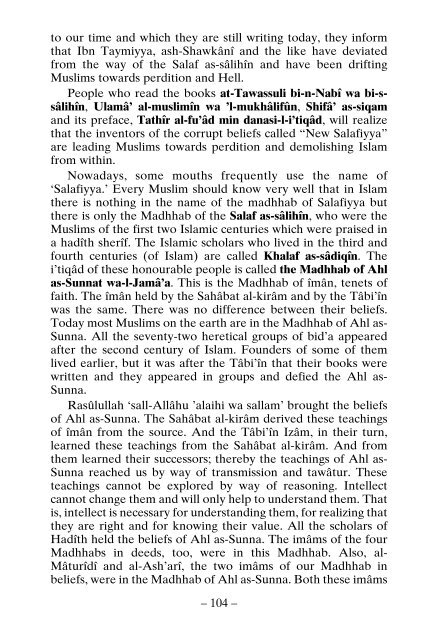Belief and Islam
BELIEF AND ISLAM star This work, Belief and Islam, originally was written in Persian under the title I’tiqâd-nâma by Hadrât Mawlânâ Khâlid al-Baghdâdî, a profound ‘âlim of Islam and a specialist in ma’ârif of tasawwuf. Hâji Faydullah Effendi of Kemah, a khalîfa of great walî Mavlânâ Mahmûd Sâhib, the brother of the author, translated the book into Turkish and named it Farâid-ul-fawâid which was printed in Istanbul in 1312 A.H.[1894]. Our bookstore had it translated again from the Persian original into Turkish and, some explanations and three chapters, published it with the title Imân ve Islâm in 1966. German, French and Arabic versions are also published by our bookstore. This book, explains five fundamentals of Islam, six fundamentals of îmân and the contemporary information about the matter and refutes those who are against Islam and those who are lâ-madbhabî.
BELIEF AND ISLAM
star This work, Belief and Islam, originally was written in Persian under the title I’tiqâd-nâma by Hadrât Mawlânâ Khâlid al-Baghdâdî, a profound ‘âlim of Islam and a specialist in ma’ârif of tasawwuf. Hâji Faydullah Effendi of Kemah, a khalîfa of great walî Mavlânâ Mahmûd Sâhib, the brother of the author, translated the book into Turkish and named it Farâid-ul-fawâid which was printed in Istanbul in 1312 A.H.[1894]. Our bookstore had it translated again from the Persian original into Turkish and, some explanations and three chapters, published it with the title Imân ve Islâm in 1966. German, French and Arabic versions are also published by our bookstore. This book, explains five fundamentals of Islam, six fundamentals of îmân and the contemporary information about the matter and refutes those who are against Islam and those who are lâ-madbhabî.
Create successful ePaper yourself
Turn your PDF publications into a flip-book with our unique Google optimized e-Paper software.
to our time <strong>and</strong> which they are still writing today, they inform<br />
that Ibn Taymiyya, ash-Shawkânî <strong>and</strong> the like have deviated<br />
from the way of the Salaf as-sâlihîn <strong>and</strong> have been drifting<br />
Muslims towards perdition <strong>and</strong> Hell.<br />
People who read the books at-Tawassuli bi-n-Nabî wa bi-ssâlihîn,<br />
Ulamâ’ al-muslimîn wa ’l-mukhâlifûn, Shifâ’ as-siqam<br />
<strong>and</strong> its preface, Tathîr al-fu’âd min danasi-l-i’tiqâd, will realize<br />
that the inventors of the corrupt beliefs called “New Salafiyya”<br />
are leading Muslims towards perdition <strong>and</strong> demolishing <strong>Islam</strong><br />
from within.<br />
Nowadays, some mouths frequently use the name of<br />
‘Salafiyya.’ Every Muslim should know very well that in <strong>Islam</strong><br />
there is nothing in the name of the madhhab of Salafiyya but<br />
there is only the Madhhab of the Salaf as-sâlihîn, who were the<br />
Muslims of the first two <strong>Islam</strong>ic centuries which were praised in<br />
a hadîth sherîf. The <strong>Islam</strong>ic scholars who lived in the third <strong>and</strong><br />
fourth centuries (of <strong>Islam</strong>) are called Khalaf as-sâdiqîn. The<br />
i’tiqâd of these honourable people is called the Madhhab of Ahl<br />
as-Sunnat wa-l-Jamâ’a. This is the Madhhab of îmân, tenets of<br />
faith. The îmân held by the Sahâbat al-kirâm <strong>and</strong> by the Tâbi’în<br />
was the same. There was no difference between their beliefs.<br />
Today most Muslims on the earth are in the Madhhab of Ahl as-<br />
Sunna. All the seventy-two heretical groups of bid’a appeared<br />
after the second century of <strong>Islam</strong>. Founders of some of them<br />
lived earlier, but it was after the Tâbi’în that their books were<br />
written <strong>and</strong> they appeared in groups <strong>and</strong> defied the Ahl as-<br />
Sunna.<br />
Rasûlullah ‘sall-Allâhu ’alaihi wa sallam’ brought the beliefs<br />
of Ahl as-Sunna. The Sahâbat al-kirâm derived these teachings<br />
of îmân from the source. And the Tâbi’în Izâm, in their turn,<br />
learned these teachings from the Sahâbat al-kirâm. And from<br />
them learned their successors; thereby the teachings of Ahl as-<br />
Sunna reached us by way of transmission <strong>and</strong> tawâtur. These<br />
teachings cannot be explored by way of reasoning. Intellect<br />
cannot change them <strong>and</strong> will only help to underst<strong>and</strong> them. That<br />
is, intellect is necessary for underst<strong>and</strong>ing them, for realizing that<br />
they are right <strong>and</strong> for knowing their value. All the scholars of<br />
Hadîth held the beliefs of Ahl as-Sunna. The imâms of the four<br />
Madhhabs in deeds, too, were in this Madhhab. Also, al-<br />
Mâturîdî <strong>and</strong> al-Ash’arî, the two imâms of our Madhhab in<br />
beliefs, were in the Madhhab of Ahl as-Sunna. Both these imâms<br />
– 104 –

















